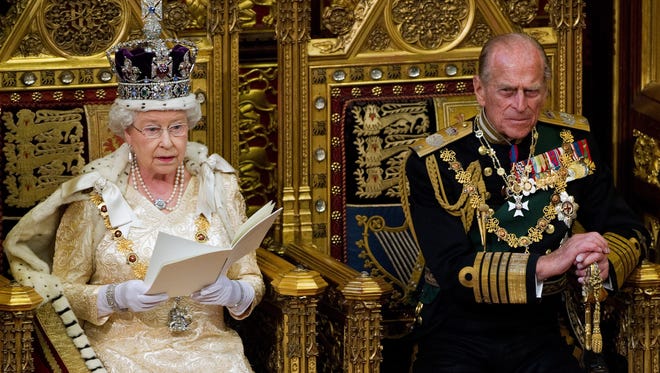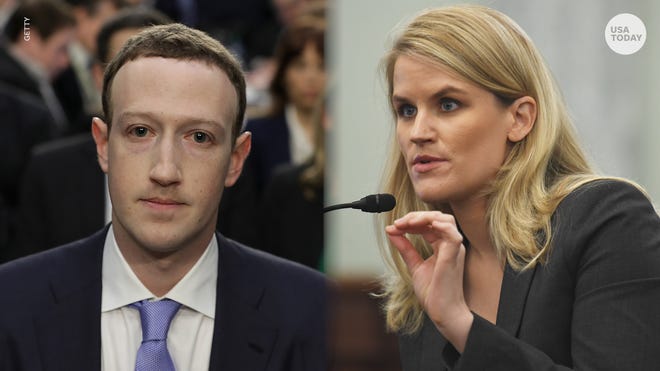
Prince Philip, the Duke of Edinburgh, the occasionally irascible but always stalwart husband of Queen Elizabeth II and Britain's oldest and longest-serving royal spouse in 10 centuries, has died. He was 99.
Buckingham Palace announced he died Friday morning at Windsor Castle.
"It is with deep sorrow that Her Majesty The Queen announces the death of her beloved husband, His Royal Highness The Prince Philip, Duke of Edinburgh," the statement read. "His Royal Highness passed away peacefully this morning at Windsor Castle."
His death is a personal loss to the monarch and to his family, and a substantial one: Most British historians and commentators believe Philip was one of the keys to the queen's enduring (69 years and counting) success as a monarch. The queen herself famously described him as her "strength and stay."
"Irreplaceable," as one of his admirers summed up in a recent film documentary, "The Real Prince Philip."
But as royal consort, Philip's passing does not affect the royal succession nor the British government. Funeral arrangements were not immediately announced but royal funerals are routinely planned years in advance. Philip's funeral plan is known as Operation Forth Bridge.
As husband of the sovereign, the duke is entitled to a state funeral, but he has expressed his preference for a private, military-style funeral at St. George's Chapel at Windsor Castle and burial nearby at Frogmore Gardens, where his great-great grandparents, Queen Victoria and Prince Albert, are interred.
Philip, who turned 99 in June 2020, had been in isolation with the queen at Windsor Castle, at Balmoral Castle in Scotland or at Wood Farm at Sandringham since March 2020 due to the COVID-19 pandemic.
But he was photographed in public twice in July 2020: He appeared with the queen at the private wedding of their granddaughter, Princess Beatrice, on July 17 on the Windsor Castle estate, and he appeared on the castle Quadrangle for a ceremonial hand over of his role as Colonel in Chief of The Rifles military regiment.
Both he and the Queen received their COVID-19 vaccines in January 2021.
Married to the queen for more than 70 years, Philip was a steady presence behind her at thousands of public events, becoming as familiar to the British people as the queen if not always as beloved.
He gave an estimated 5,000 speeches, according to Buckingham Palace, and carried out about 32,000 solo engagements between 1952 and 2017. But he also became famous, and infamous, for making funny, sharp, insensitive or even racially offensive remarks in public.

The royal household had been planning celebrations to mark Philip’s 100th birthday on June 10, assuming coronavirus lockdown restrictions allowed it.
Philip's death comes as the royal family is in the midst of another damaging crisis, after his grandson, Prince Harry, and Harry's wife, Duchess Meghan of Sussex, spoke to Oprah Winfrey for an interview aired on CBS on March 7, 2021. The couple shocked the world when they said they gave up their royal roles in 2020 and fled to America because of racism in the family and the media, and because the palace refused to help Meghan, a biracial American, deal with suicidal thoughts when she became depressed by the pressure.
Winfrey later clarified that Harry said that neither the queen nor Philip were the close relative they described as expressing concerns when she was pregnant about how dark her baby's skin color would be. But they have declined to say who it was.
The queen issued a statement two days later saying the family would deal with the uproar privately within the family, and that "some recollections may vary" about who said what to whom.
The signs of an approaching end were already visible for Prince Philip.
The prince was admitted to London's King Edward VII Hospital on Feb. 16 after feeling unwell. Buckingham Palace said it was a precautionary measure and noted he was expected to remain there for a few days of observation, rest and treatment of an infection. He was transferred to another hospital, St Bartholomew's, for a successful heart procedure, and then returned to King Edward VII's hospital. He was released and returned to Windsor Castle on March 16, 2021. It was the longest hospitalization of his life.
The last time he was hospitalized, in December 2019, it was for "observation and treatment" as a "precautionary measure" to treat a pre-existing condition.
On Jan. 17, 2019 he emerged unscathed from a car wreck near the royal Sandringham estate. He decided to give up his license after the crash, in which two women in the other car were injured, but not seriously.
Retired from public life, he attended the wedding of his grandson Prince Harry to the former American actress Meghan Markle at Windsor Castle in May 2018, about a month after he was hospitalized for successful hip replacement surgery. He also was seen at the wedding of granddaughter Princess Eugenie in October 2018.
Philip departs the royal stage at a time when his family is in another paroxysm over the role of one of its most beloved members, Prince Harry, younger son of the late Princess Diana, the last royal at the center of national controversy, who died in 1997.
Harry, 36, and Meghan, 39, the Duke and Duchess of Sussex, announced in January 2020 they were giving up their royal roles and moving with their baby son Archie to North America in search of more freedom, privacy and financial independence. They now live in Santa Barbara County, California, where they have signed lucrative deals with Netflix and Spotify to produce entertainment, documentaries and podcasts.
They are not returning anytime soon, in part due to the coronavirus pandemic and because Meghan is pregnant with their second child. But also because this is the life they have chosen for themselves, to the regret of Harry's royal relatives and the fury of the British tabloids.
For the first time in history, a member of the family, relatively close to the throne, will have a permanent foothold in America, including an American citizen descendant. It is not clear what Philip would have thought of this twist on the "special relationship" between Britain and America, because he has not been speaking in public for some years.
In May 2017, he announced that he would retire for good, though he also said he might choose to attend certain public events from time to time. In fact, he had cut back on his public duties after reaching his ninth decade, but up until his retirement he still carried out scores of engagements annually, alone or with the queen, despite ups and downs in his health.
In June 2017, when he was supposed to accompany the queen to the annual State Opening of Parliament ritual, Buckingham Palace announced that Philip had been hospitalized as a "precautionary measure" for an infection stemming from an existing condition. (Prince Charles instead accompanied the monarch to the ceremony.)
On May 3, 2017, he carried out one of his last engagements at one of his favorite places, Lord's Cricket Ground, where he cut the ribbon and unveiled a plaque for a new viewing stand. "You're about to see the world's most experienced plaque unveiler," he joked to those watching.
The duke had been hospitalized multiple times since the end of 2011, when the state of his health became a more pressing concern in Britain. In December of that year, he was rushed to the hospital when he suffered chest pains during the royal family's annual Christmas holiday at Sandringham, the queen's Norfolk estate.
He underwent an emergency stent procedure to correct a blocked artery and was released four days later, joining the family for New Year's Day church services.
He also was hospitalized in 2012, during his wife's Diamond Jubilee celebrations, for what was described as a sudden bladder infection. The queen carried on. For a morning church service, she walked alone up the aisle when ordinarily she would have been accompanied by Philip, a few steps behind her. It gave the British a stark picture of what the future held without Prince Philip by their queen's side.
Source link










